


Minam Apang (b. 1980, India), The sleeping army may stir (detail), 2009, Ink andsynthetic polmer paint on fabriano cold pressed paper; 70 x 240 cm; Collection of Isabelle Levy and Geraldine Galateau, paris; Image courtesy of artist and Chatterjee and Lal, Mumbai
The Sixth Asia Pacific Triennial pushed its expeditionary charter ever further this year embracing Tibet, North Korea, West Asia [Iran and Turkey], Cambodia, Myanmar and Vanuatu for the first time. While this geography-based exhibition has consistently attempted to navigate this territory we define as ‘the Asia Pacific’ – its history, nuances and contemporary definitions – a question on peoples minds was have they gone too far? Has the exhibition become an institutional brand brokered on mass appeal or is ‘dissonance’ alive and probing?
I proposed these questions to four artists and curators who had in varying ways experiences the exhibition: Clarissa “Lisa” Chikiamco (LC), Ho Tzu Nyen (HTN), Shooshie Sulaiman (SS) and Rich Streitmatter-Tran. Sadly Rich was unable to join us due to commitments, despite lending his support. What came out of this series of emails over a two-week period was a dialogue challenging and fresh. It probed curatorial practice in our region today. Enjoy it over two Parts published here on ARTERI.
Gina Fairley

Gonkar Gyatso (b. 1961, Tibet/England), Installation View APT6, Stickers and pencil on treated paper; ‘Angel’ collection of Queensland Art Gallery; Photograph by Gina Fairley
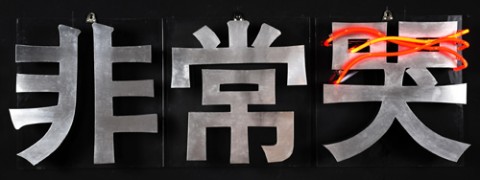
Cheo Chai-Hiang (b. 1946, Singapore), Fei Chang Ku 2007, Stainless steel, perspex, neon; 3 parts: 53 x 55 x 13 cm (each), Image courtesy of the artist and NAFA
Gina Fairley: What do you think was the most successful aspect of APT6 and what was most problematic for you?
Lisa Chikiamco: The most problematic thing for me was the ‘Asianness’ of the exhibition and by that I mean it had too much art that presented Asian traditions ‘with a twist’. The APT contributes to a dialogue and focus on contemporary art by artists of the region, but does the art have to be about the region? In the year 2010, do Asian artists need to make art about their ‘Asianness’ in order to be included in a triennial? There were a number of works that were quite powerful when considered individually, outside this frame. I think it is perfectly fine for contemporary artists to choose to focus on local traditions.
Ho Tzu Nyen: I would like to ask Lisa if she could define this ‘Asianness’ she speaks of, and has such a problem with. For example, if we use the example of Hiraki Sawa’s spinning objects and animated videos, are you able to pinpoint exactly what is ‘Asian’ about the work?
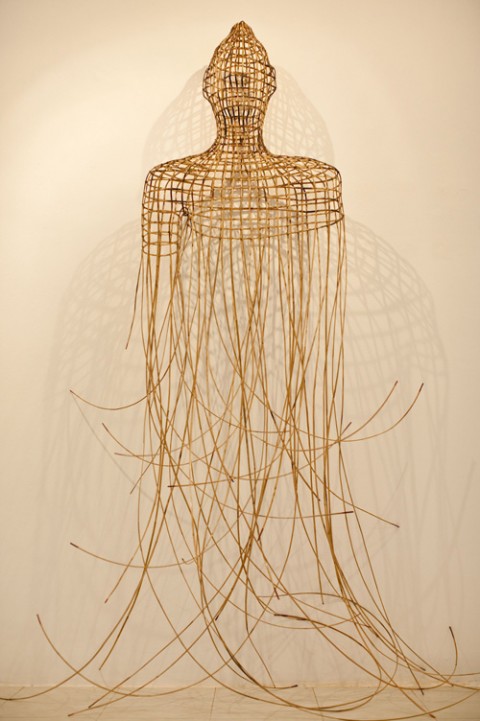
Sopheap Pich (b. 1971, Cambodia), Buddha (from ‘1979’ series) 2009, Rattan, wire, dye; Installed dimensions: 220 x 110 x 30 cm; Project for APT6; Courtesy of the artist and Queensland Art Gallery; Photograph by Vandy Rattana
LC: Tzu does raise a good question. I should clarify that I had the impression that too much of the art had this ‘Asianness’ (yes, a loaded term most definitely) but certainly not all the works were defined by it. In retrospect, the wall text accompanying each work gave me that idea more so than the artworks themselves. For example the text would highlight calligraphy, Buddhism, classic Persian tales, local traditions in India, aesthetics of Iranian culture, Indonesian music and so on – it was a loaded entree to engagement. However as the writer referencing the work it would probably have been unavoidable since the artist’s source is from local contexts.
GF: Asianness is a tricky one. If anything I felt the exhibition has increasingly drifted from its Asian foundations, presenting more as a group exhibition flavoured by its ever-so-popular public programs, increasingly embedded into the core exhibition. The more successful dialogue around ‘Asianness’ – both in terms of geography and psychology – I think was The Mekong Project, one of the focus cells of APT6 that stretched across three generations and five nations and yet, it was mapped against a contemporary terrain.
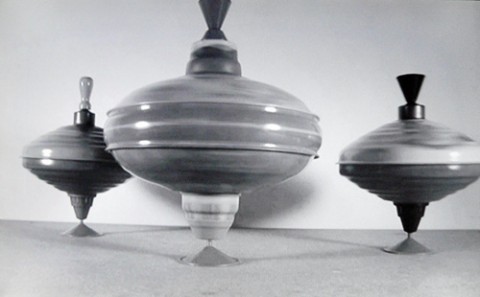
Hiraki Sawa (b. 1977, Japan), Elsewhere 2003, Digital video on DVD, single channel, continuous loop, black and white, sound 7.40 minutes; Courtesy of the artist, Ota Fine Arts, Tokyo and James Cohan Gallery, New York
Sooshie Sulaiman: I think the most interesting aspect of APT6 was its ‘boldness’ of aesthetic terminology. APT6 is more polished in terms of the understanding of bigger scale events in this region per se and obeys a very clear aesthetic goal to stimulate communication between the institution, artists and the public. It is so obvious, and critically interesting, to observe [through the exhibition] that the artists in this region adore and are rooted by formalistic and aesthetic integrity.
The problem that I personally encountered with APT6 was that the tangible and retinal successes were the only elements highly addressed and being capitalized upon. The intangible or the mystical component that flows naturally in the blood of the artists (either declared or not declared) in this region doesn’t seem an ideological goal to address our history, or its narration. It is not even presented as a sub-product! One can’t really enjoy the contradictions between aesthetic adoration, formalistic skills and mystical fragmentation because they are so bound up and intertwined into the APTs own value system.
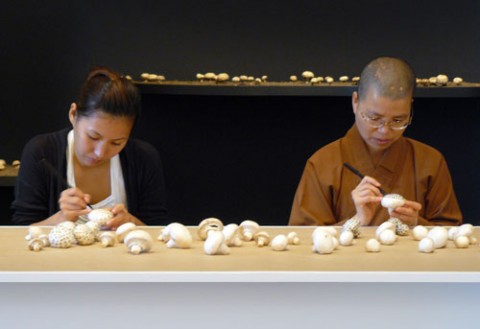
Charwei Tsai (b. 1980, Taiwan), Mushroom Mantra 2008 – Performance with local Buddhist monks APT6, Queensland Art Gallery, Brisbane; Black ink on fresh mushrooms; Photograph by Gina Fairley
LC: [I have to agree with Shooshie’s comment], I cannot escape the impression that the show had some fashionable contemporary exotic feeling about it.
HTZ: Could you perhaps define that “contemporary exotic feeling”?
LC: ‘Contemporary’ obviously comes from its genre of being contemporary art, while ‘exotic’ seems to stem from the APT as a geography-based exhibition. The art and artists in a way become unwitting representatives from the culture they represent. I agree for the most part with Jeff Gibson when he wrote about previous APTs, “…it is unavoidable in any such regional survey that the participating artists bear the burden of national representation, even when it is not an explicit organizing principle.” This feeling I had was also, I think, significantly helped along by overhearing a white Australian murmur to his companion on Monir Farmanfarmaian’s work, “Yes, it’s very Iranian…” The possibility of pigeonholing seems to me to increase in this curatorial set-up.

Raafat Ishak (b. 1967, Egypt/Australia), Untitled (from ‘Emergencies, Accidents and Congratulations’ series) 2009, Synthetic polymer paint on MDF; 20 panels: 60 x 42 cm (each); Coutersy of the artist and Sutteon Gallery, Melbourne; Photograph by Nick Kreisler
GF: This ‘exotic’ other is – to use a white colonialist term – exploited in Tracy Moffat’s film OTHER (2009), a fast-paced sexy montage of Hollywood’s great encounters with the ‘exotic other’, rising to a crescendo of passion and racial/gender taboo. It is an interesting comparison across APT6 with Shooshie’s Darkroom that also speaks about gender, cultural clash and certain social taboos. While both raise similar issues, one is wrapped in humility and enquiry while the other is brash humour and fait acompli. What is lost in this exhibition is that kind of cross-platform examination between works and ideas-the threads are too obscured. Is dissonance then about ‘us’ and ‘them’? Surely we’d all hope we’d moved beyond that parochial position.
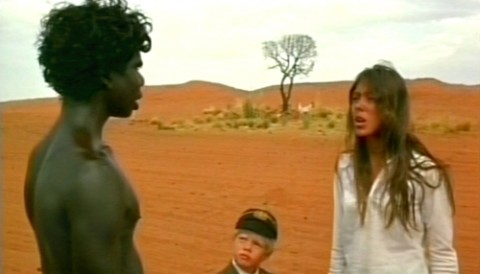
Tracey Moffatt (Australia), OTHER 2009, Still from a video by Trcey Moffatt and Gary Hilberg; DVD transferred to Digital Betacam, single channel projection, continuous loop, colour, sound, 6.22 minutes, ed. 1/150; Courtesy of the artists
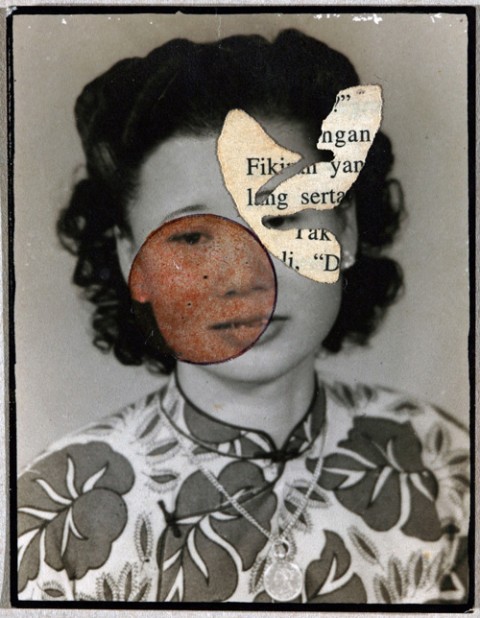
Sooshie Sulaiman (b. 1973, Malaysia), Masculine Moth’s Eye 2009, Paper, oil paint, photograph, 6.9 x 8.9 cm, Image courtesy of the artist and Queensland Art Gallery
LC: My use of ‘contemporary exotic feeling’, I think relates to what you said, Gina, about the great sense of disconnection. I suppose I wouldn’t feel the same way if it weren’t so difficult to find the threads connecting the juxtapositions (were there threads?). It brings me to say that for the APT to stay relevant, it needs to evolve into a focused and themed exhibition – which I feel it currently isn’t.
HTN: I am curious about your comment that APT6 needs to ‘evolve’ into ‘a focused and themed exhibition’. I would like to ask if you think that becoming focused and themed (and thus becoming like almost every other biennial or triennial out there) is the only available path for being ‘relevant’? Becoming focused and themed sounds a bit like the pre-requisites for growing up, and maturity.
“Relevant” to whom – I might add – is it some kind of teleological imperative? For argument’s sake, what if APT6’s very raison d’être is to have no theme and no focus. What if the whole practice of attempting to find threads or conversations between artworks is foreign to the curators’ intentions? What if they really just intended for the show to be a collection of heterogeneous objects, each to be seen just ‘in its own light’? Then perhaps criticizing the ‘disconnect’ is a little like barking up the wrong tree, or like blaming someone for not having something he or she doesn’t wish to possess in the first place. I am not exempting APT from critique but rather suggesting that we should first try to define what we think the aims the APT sets for itself before evaluating its performance and thinking through the broader ideological implications of these criteria and aims.
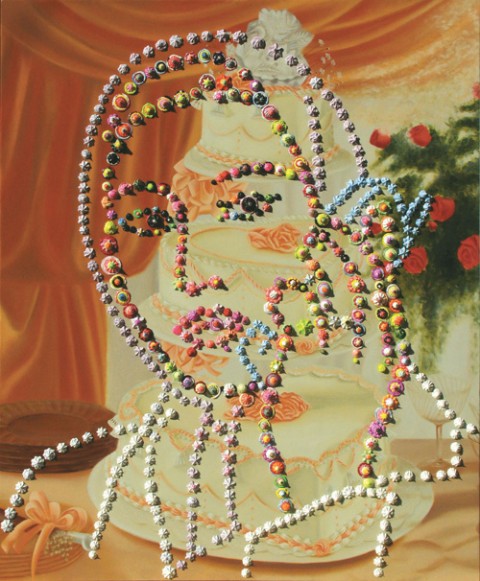
Farhad Moshiri (Iran), Mobile Talker 2007, Oil, synthetic polymer paint and glitter on canvas; 170 x 140 cm; Private collection in Dubai. Courtesy of the artist and The Third Line, Dubai.
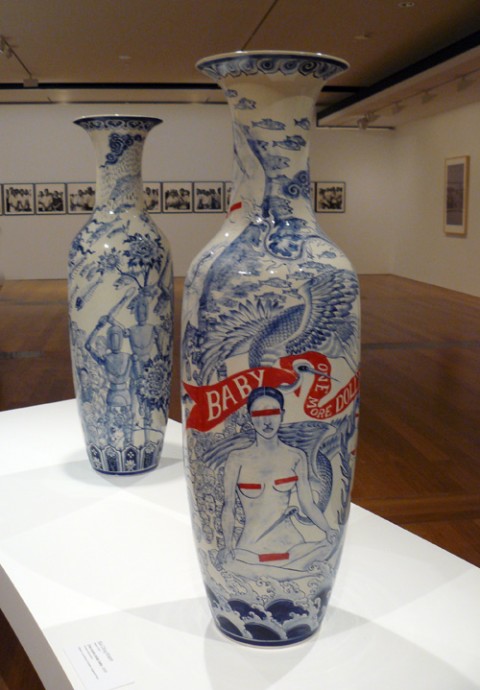
Bùi Công Khánh (b. 1972, Vietnam), Installation view ceramics, hand painted porcelain, 126 x 36 x 36 cm (each), Project for APT6, The Mekong Project; Photograph by Gina Fairley
GF: Tzu you raise some very interesting and current arguments about themes. We just have to recall Okwei Enwezor’s two seminal exhibitions – documenta 11 in 1997 where art works were gathered according to ‘political colour’ standing on the politics of trauma and the third world [the exotic other to use that earlier term], to his 2009 Gwanju Biennial where artworks were displayed without themes or a framing concept. Perhaps we have moved past the ghosts of the 20thc Expo and need to evaluate, as you suggest, a new set of criteria for large-scale exhibitions.
LC: It is an interesting thought. Tzu is quite right – a theme or focus would make it like every other biennale and yes, perhaps it’s a matter of background and taste. I do wonder though how the curators select the works or commissions without a theme. Would it be purely taste then? Does the collecting policy—since GoMA buys several of the works in the APT—become a factor?
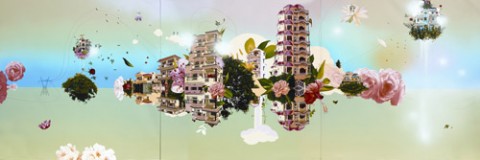
Thukral & Tagra (Jiten Thukral b 1976, India/ Sumir Tagra b. 1979, India), Dominus Aeries – The Great, Grand Mirage 2009, Synthetic polymer paint and oil on canvas, Triptych: 213.5 x 213.5 (each); Courtesy of the artists and Gallery Nature Morte, New Delhi.
GF: A point I made in a critical review of APT5 was that 70% of the exhibition was acquired and in that action of ‘sound acquisition choices’ the critical edge had been lost. I was curious to run the figures this year. They are a little hard to be exact [I worked off the exhibition catalogue] but by my count 39 works were purchased in 2008 and 33 in 2009. For me both equate to APT6 purchases as they were clearly made leading into and with the APT as an agenda to be shown. So that is a total of 72 works, which represents about 38%. And if we remove the Korean studio works from the total count of artworks as they are owned by a private collection, that figure starts to look more like 50%. Remembering that we are talking about acquisition here not the commissioning of new works for the exhibition. It is a staggering agenda that can only skew curatorial decisions, in my opinion.

Monir Shahroudy Farmanfarmaian (b. 1924, Iran), Lightning for Neda 2009, Miroor mosaic, reverse glass painting, 6 panels: 300 x 200 cm (each); Commissioned for APT6 and the Queensland Art Gallery Collection. The artist dedicates this work to the loving memory of her late husband Dr. Abolbashar Farmanfarmaian; Photograph by Gina Fairley

As above (detail)
It is an interesting point to stop on. The institution makes no secret that one of the agendas of the APT is to collect the art of the region – almost as a custodian for future generations. Singapore Art Museum plays a similar role. But, as I understand, the Singapore Biennale has not added to this collection in the past as a proactive agenda. It will be interesting to observe with its next edition in 2011, as it becomes embraced into the folds of the mega-conglomerate of SAM and the new National Art Galley as umbrella institutions. What are your thoughts ARTERI readers?
One of the more discussed topics surrounding APT6 was its ‘loose’ concept of dissonance. Perhaps it is totally visionary to herald discord and loud clashes when these systems are aggregated by their own institutional strength. This is an idea I will bring to the ‘APT6 Roundtable’ in Part II.

Mansudae Art Studio (Kim Hung Il & Kang Yong Sam, North Korea), Work Team Contest, 2009; Glass tile, paper and board; 350 x 570 cm; Commissioned for APT 6 and Queensland Art Gallery with assistance of Nicholas Bonner. Photograph by Gina Fairley
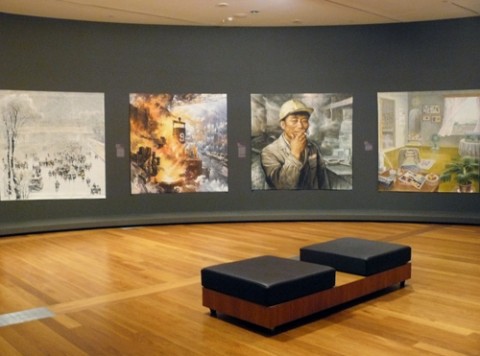
Installation view Mansudae Art Studio Project for APT6, Gallery of Modern Art, Brisbane, 2009, Photograph by Gina Fairley
~
Both the work of Ho Tzu Yuen [Singapore] and Shooshie Sulaiman [Malaysia] were presented in APT6. Clarissa “Lisa” Chikiamco [Philippines] has just completed her MA in Art Curatorship from the University of Melbourne and caught APT6 enroute to returning to the Philippines; and Gina Fairley is a freelance writer specialising in Southeast Asian contemporary art. She was formerly Exhibition Co-ordinator for the Biennale of Sydney.
This roundtable has also been published by www.slot.net.au and excerpts in the Philippines. I want to thank all involved for their generous support and candid conversation.
Part II of the roundtable will be published next Monday on ARTERI.
Sorry, the comment form is closed at this time.
on the exotic – possibly relative? after all your “exotic” could just be my everyday. naive as it may sound & not unaware of the problems with being objectified as the “other” – part of the wonder of art for me and i think for many others, is that it does expose us to things we don’t normally encounter. a window into someone else’s private world or local culture. still. globalisation may flatten many parts of our life into a kind of global vernacular where we’re all watching the same pirated movies, but only up to a certain extent. face it, these events are like being a contestant in the Ms. Universe of contemporary art anyway. what is the preferable alternative to doing “asian tradition with a twist”? an increasingly international standard of installation based conceptual art referencing each other in demi-code?
GF: So wut u like and dun like about d show ah?
LC: Yerrrr the arts so ‘asian’ wan loh..sian lah
HTN: lulz…wut you mean by asian ah…
LC: Eh u so blur go read the wall text lah
GF: heh heh not asian la, only one very asian
SS: I like show!Very pretty. But then horrrr..so pretty until i dun feel d magic r d (T_T)
LC:True dat. I feel the contemporary exotic feel ing in it
HTN: lulz…wut you mean “contemporary exotic feeling”?
LC: Duhhhh ‘contemporary’ also dun know ah? Exotic, aiya, we asian showing art to white feller mah, exotic loh. Go read Jeff Gibson lah. I hear the white feller at show say “Yes, it’s very Iranian” an i felt geli.
GF:Moffat white lady do art on exotics, SS do art on exotics, but the two dun show together-gether, why ah? Why the show just show asians ah? Asians still not gnam with white flers ah? no lah right?
LC:Yaloh Gina. The show should evolve, focused, and themed
HTN:lulz..wut you mean by (too long, lost interest)
Great pics! Looking forward to part 2.
walau eh so much bootifool art to buy n decorate my bungalow with… sam moh garantit asian-made!
我非常爱亞洲的后庭花。